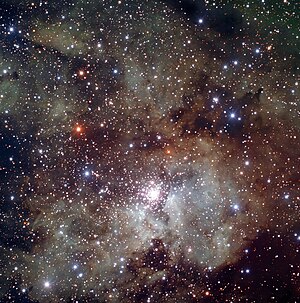NGC 3603
NGC 3603是一个距离地球约20000光年,位于银河系旋臂内的星云,在天球上位于船底座。该星云是一个巨大的电离氢区,内部包含了一个极为紧凑的疏散星团(可能是超星团)HD 97950。
| 星云 | |
|---|---|
| 电离氢区 | |
 NGC 3603的可见光与近红外线影像 | |
| 观测资料: J2000 epoch | |
| 赤经 | 11h 15m 23s[1] |
| 赤纬 | -61° 15′ 00″[1] |
| 距离 | 6,900[2] 秒差距 |
| 视星等 (V) | 9.1[3] |
| 视直径 | 12.0'[3] |
| 星座 | 船底座 |
| 值得注意的特征 | 中心区域是年轻的星团HD 97950 [4] |
| 名称 | Gum 38b |
观测
编辑NGC 3603是约翰·赫歇尔在访问南非时于1834年3月14日发现的,他的注记说这是一个非常显著的天体……可能是一个球状星团。它在1847年出版的南非好望角天文观测结果中被标示为星云3334。在1864年皇家学会出版的星云和星团总表中是2354号。之后他被约翰·路易·埃米尔·德雷耳收录到NGC中成为NGC 3603[5]。
NGC 3603中心的天体被编号为HD 97950,长期以来被认为是模糊的星云或多重恒星系[5]。天文学家还注意到在该系统观测到不寻常的发射光谱线,因此在HD星表中将它的光谱型分类为Oe。后来分类被修改为WN5 + O,这是因为发射谱线通常被认为是沃尔夫–拉叶星的特性[5]。最后,HD 97950被解析为包含已知质量最大和光度最高的的其中3颗恒星,以及多颗高光度O型恒星以及更多较暗恒星[6]。
特征
编辑NGC 3603是银河系中最大质量的可见发光气体云与电浆区域,也就是 H II区域 [7]。中央的星团是银河系中高质量恒星分布密度最高区域。强烈的紫外线等电磁辐射与恒星风清除了邻近区域的气体与尘埃,让该星团邻近区域未被掩蔽[8]。
在星团内已经检测出三颗耀眼的沃尔夫-拉叶星 ,而这三颗恒星原本无法被解析而编号为单颗恒星HD 97950。三颗中最明亮的NGC 3603-A1或(HD 97950A1),是由两颗沃尔夫-拉叶星组成的联星,轨道周期3.77日。系统中主星的质量估计为120 M☉,伴星质量则估计92 M☉。系统中的另一颗恒星HD 97950B的质量与光度则高于HD 97950A1联星系统中任一成员星。HD 97950B的光度为太阳的288万倍,质量为太阳的132倍[9]。
在可见光望远镜中看见的NGC 3603是一个因为星际吸收影响的不显眼淡黄色小规模星云。但在1960年代中期,可见光与无线电波对NGC 3603的合并观测显示该区域是一个极为强烈的热辐射源。之后对于其他星系的观测引进了星暴区域的概念,即快速形成大量恒星。NGC 3603现在就被认为是星暴区域,并有部分天文学家将它和大麦哲伦星系中更大的此种区域蜘蛛星云做比较[10]。
位于NGC 3603外围区域的B型超巨星Sher 25周围被喷出的物质呈现类似超新星SN 1987A的沙漏形,这引起了天文学家对该恒星的未来演化的强烈兴趣[11]。
有两颗已知光度最高的年轻恒星位于NGC 3603范围内,但位于中心的星团之外。WR 42e和NGC 3603 MTT 58的光谱型都是O2If*/WN6,代表两颗恒星都是极高质量的年轻恒星。WR 42e可能是在一次不寻常的三体运动中被抛出,而MTT 58看起来仍就位于该恒星形成的气体茧中,并且旁边可能有一颗O3If伴星的联星系统[12]。
参考资料
编辑- ^ 1.0 1.1 Kharchenko, N. V.; Piskunov, A. E.; Schilbach, E.; Röser, S.; Scholz, R.-D. Global survey of star clusters in the Milky Way. II. The catalogue of basic parameters. Astronomy & Astrophysics. 2013, 558: A53. Bibcode:2013A&A...558A..53K. arXiv:1308.5822 . doi:10.1051/0004-6361/201322302.
- ^ Pang, Xiaoying; Grebel, Eva K.; Allison, Richard J.; Goodwin, Simon P.; Altmann, Martin; Harbeck, Daniel; Moffat, Anthony F. J.; Drissen, Laurent. On the Origin of Mass Segregation in NGC 3603. The Astrophysical Journal. 2013, 764: 73. Bibcode:2013ApJ...764...73P. arXiv:1212.4566 . doi:10.1088/0004-637X/764/1/73.
- ^ 3.0 3.1 Sinnott, Roger W. The complete new general catalogue and index catalogues of nebulae and star clusters by J. L. E. Dreyer. Cambridge: Sky Publishing Corporation and Cambridge University Press. 1988. Bibcode:1988cngc.book.....S.
- ^ SIMBAD Astronomical Database. Results for NGC 3603. [2006-11-28]. (原始内容存档于2013-08-17).
- ^ 5.0 5.1 5.2 Sher, D. The Curious History of NGC 3603. Journal of the Royal Astronomical Society of Canada. 1965, 59: 67–70. Bibcode:1965JRASC..59...67S.
- ^ Harayama, Y.; Eisenhauer, F.; Martins, F. The Initial Mass Function of the Massive Star-forming Region NGC 3603 from Near-Infrared Adaptive Optics Observations. The Astrophysical Journal. 2008, 675 (2): 1319. Bibcode:2008ApJ...675.1319H. arXiv:0710.2882 . doi:10.1086/524650.
- ^ Brandl, B.; Brandner, W.; Grebel, E. K.; Zinnecker, H. VLT/ISAAC and HST/WFPC2 observations of NGC 3603. The Messenger. 1999, 98: 46. Bibcode:1999Msngr..98...46B.
- ^ Drissen, Laurent; Moffat, Anthony F. J.; Walborn, Nolan R.; Shara, Michael M. The Dense Galactic Starburst NGC 3603. I. HST/FOS Spectroscopy of Individual Stars in the Core and the source of Ionization and Kinetic Energy. Astronomical Journal. 1995, 110: 2235. Bibcode:1995AJ....110.2235D. doi:10.1086/117684.
- ^ Crowther, P. A.; Schnurr, O.; Hirschi, R.; Yusof, N.; Parker, R. J.; Goodwin, S. P.; Kassim, H. A. The R136 star cluster hosts several stars whose individual masses greatly exceed the accepted 150 M⊙ stellar mass limit. Monthly Notices of the Royal Astronomical Society. 2010, 408 (2): 731. Bibcode:2010MNRAS.408..731C. arXiv:1007.3284 . doi:10.1111/j.1365-2966.2010.17167.x.
- ^ Melnick, J.; Tapia, M.; Terlevich, R. The galactic giant H II region NGC 3603. Astronomy and Astrophysics. 1989, 213: 89. Bibcode:1989A&A...213...89M.
- ^ Hendry, M. A.; Smartt, S. J.; Skillman, E. D.; Evans, C. J.; Trundle, C.; Lennon, D. J.; Crowther, P. A.; Hunter, I. The blue supergiant Sher 25 and its intriguing hourglass nebula. Monthly Notices of the Royal Astronomical Society. 2008, 388 (3): 1127. Bibcode:2008MNRAS.388.1127H. arXiv:0803.4262 . doi:10.1111/j.1365-2966.2008.13347.x.
- ^ Roman-Lopes, A. An O2 If*/WN6 star caught in the act in a compact H II region in the starburst cluster NGC 3603. Monthly Notices of the Royal Astronomical Society. 2013, 433: 712. Bibcode:2013MNRAS.433..712R. arXiv:1305.0851 . doi:10.1093/mnras/stt762.
外部链接
编辑- Hubble Space Telescope: Star Cluster Bursts into Life in New Hubble Image(页面存档备份,存于互联网档案馆)
- European Southern Observatory: The Stars behind the Curtain(页面存档备份,存于互联网档案馆)
| 天文学目录 | ||
|---|---|---|
| NGC天体表: | NGC 3601 - NGC 3602 - NGC 3603 - NGC 3604 - NGC 3605 | |